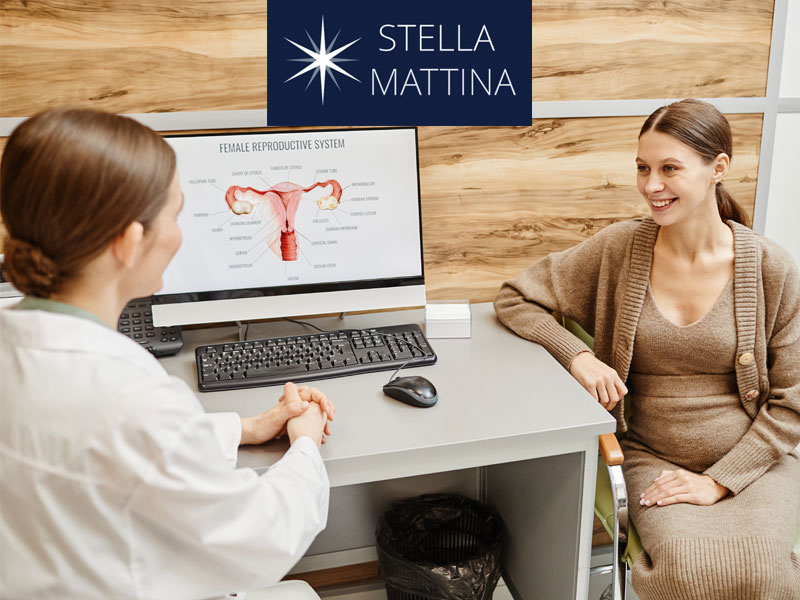
Living with endometriosis and considering pregnancy? You’ll want to understand how endometriosis may impact your journey. As March is Endometriosis Awareness Month, this is the perfect time to shed light on endometriosis and pregnancy. You can then make informed decisions.
But why have a month of endometriosis awareness? You may be surprised to hear that globally, endometriosis affects approximately 1 in 10 women of menstruating age. Yet, although it’s a common condition, it’s still little understood.
So let’s start at the beginning with a quick recall of the facts.
What is Endometriosis?
Endometriosis occurs when tissue similar to your uterine lining (endometrium) grows outside your uterus. This commonly affects areas such as your ovaries, fallopian tubes, and pelvic lining.
These abnormal tissue growths react to hormonal changes during your menstrual cycle, causing inflammation, pain, and fertility challenges.
How Do Gynecologists Check for Endometriosis?
Diagnosing endometriosis can be challenging since symptoms vary and some of them often resemble other conditions such as PCOS. Gynecologists use a combination of methods to assess and confirm the diagnosis:
- A pelvic exam is needed to identify cysts or areas of tenderness – though smaller lesions may go undetected.
- A transvaginal or abdominal ultrasound can detect ovarian cysts (endometriomas) but cannot confirm endometriosis.
- MRI provides detailed images to assess deep infiltrating endometriosis.
- Laparoscopy is a minimally invasive surgery that allows direct visualization and biopsy, making it the most definitive diagnostic method.
What Are the Three Signs of Endometriosis?
Recognizing endometriosis early can help you manage symptoms effectively, and the three most common signs are:
- Painful periods (dysmenorrhea) that often worsen over time.
- Chronic pelvic pain even between menstrual cycles.
- Discomfort or pain during or after intercourse.
The Four Stages of Endometriosis
Medical experts classify endometriosis into four stages based on the severity and extent of the disease:
Stage I: Minimal Endometriosis
Small patches of endometrial tissue appear scattered within the pelvic cavity. Symptoms may include mild pelvic discomfort or menstrual pain, but can sometimes be minimal or absent.
Stage II: Mild Endometriosis
Larger endometrial implants affect multiple pelvic organs, leading to moderate pelvic pain, especially during menstruation and ovulation – with increased risk of infertility.
Stage III: Moderate Endometriosis
There is extensive involvement of pelvic structures with significant adhesions and scar tissue. Severe pelvic pain, gastrointestinal symptoms, and increased infertility risks are common.
Stage IV: Severe Endometriosis
This stage sees extensive pelvic involvement with significant adhesions; deeply infiltrating endometrial implants affecting vital structures like bladder and bowel; and profound symptoms, including severe pain and infertility challenges.
How Does Endometriosis Affect Fertility?
Understanding the relationship between endometriosis and your pregnancy chances can ease some of your concerns.
Endometriosis affects fertility primarily by causing inflammation, scarring, and adhesions around your reproductive organs. This can disrupt egg release, fertilization, or implantation because it creates an unfavorable environment for conception.
However, while endometriosis can decrease your fertility, it doesn’t necessarily mean pregnancy is impossible. The good news is that many women with endometriosis successfully conceive naturally or with medical assistance.
Pregnancy and Endometriosis: Understanding the Risks
When talking about endometriosis and pregnancy, it’s important to keep in mind the challenges and considerations that come with it. We’ll review each.
Disease Severity
The severity of endometriosis can vary greatly. Mild endometriosis may have a minimal impact on your fertility, while moderate to severe cases might pose greater challenges due to extensive scarring or blockage of your fallopian tubes. Be sure to consult a fertility specialist who will be able to evaluate your specific situation and recommend tailored solutions.
Medical and Surgical Treatments
Various treatment options can improve fertility if you’re struggling to conceive. Hormonal treatments can reduce symptoms – although you typically need to avoid these when actively trying to conceive.
Surgical options, such as laparoscopy to remove endometriosis lesions, may significantly enhance your pregnancy chances by improving the condition of your pelvic area.
Endometriosis and Ectopic Pregnancy
Women with endometriosis should be aware of certain increased risks, including ectopic pregnancy – a potentially serious condition where a fertilized egg implants outside your uterus, usually in your fallopian tubes.
Scarring from endometriosis can partially block these tubes so that the egg cannot travel in the normal way to your uterus. This raises the risk of it implanting in the wrong place.
Doctors recommend early ultrasound and close monitoring during early pregnancy to detect and address this condition promptly.
Endometriosis and Early Pregnancy Symptoms
Recognizing early pregnancy symptoms can be challenging if you have endometriosis and pregnancy-related discomfort, as some symptoms overlap.
Typical pregnancy signs include fatigue, nausea, breast tenderness, and mild cramping. However, if you have endometriosis, it’s possible you may notice heightened pelvic pain or discomfort during early pregnancy.
Tips for a Healthy Pregnancy with Endometriosis
If you’re pregnant or trying to conceive, proactive management can significantly enhance your pregnancy experience. Here are some tips to help:
- Take advantage of all your prenatal visits to monitor your health closely, manage pain effectively, and address complications immediately.
- Eat a balanced diet rich in anti-inflammatory nutrients like omega-3 fatty acids, antioxidants, and fiber.
- Stay active through gentle exercises like yoga or walking.
- Reduce stress through mindfulness or meditation.
- Consult your healthcare provider for safe pain management strategies during pregnancy.
- Work with a fertility expert early in your pregnancy to make your journey smoother.
Emotional Support and Coping Strategies
Navigating endometriosis and pregnancy can be emotionally challenging. We totally get that. Our advice is to build a supportive network – including your healthcare providers, support groups, or counseling – to give you much-needed emotional relief and encouragement!
Raising Awareness: March is Endometriosis Awareness Month
As mentioned up top, every March, people around the world come together to raise awareness about endometriosis through education, advocacy, and mutual support.
You can get involved by joining online support communities, sharing reliable information on social media, or attending local awareness events.
Taking part in these activities can help you better understand your condition, connect with others facing similar experiences, and find valuable resources to support you throughout your pregnancy journey.
Managing Endometriosis and Pregnancy with Stella Mattina
Suffering from endometriosis and being pregnant can be challenging, but with informed healthcare decisions and supportive care, many women have successful pregnancies. Understanding how endometriosis and pregnancy are interconnected allows you to approach your journey with greater confidence and preparedness.
At Stella Mattina, we have skilled gynecologists and obstetricians with decades of experience in women’s health – who can help you conceive and have a healthy pregnancy. Choose your nearest location and come and talk to us.
Dr. Krum is currently in practice in Arlington, TX. He received his undergraduate degree at Texas A&M University, then attended UTMB Galveston for medical school, finishing in 1986, completing his residency there in 1990. Providing a full range of obstetrical and gynecological care, he specializes in the treatment of endometriosis and robotic surgery. He arranges his schedule so that same-day appointments are usually available.
